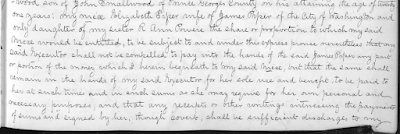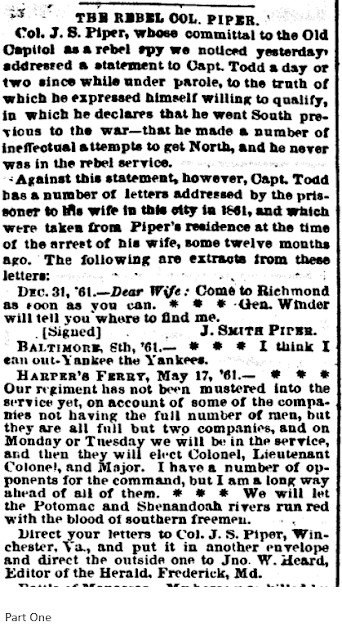© Kathy Duncan, 2025
The next step in my research of the Moore siblings was to place them in the same county at the same time. What was their origin? I found the following Moore siblings married in Jefferson County, Alabama:
Wiley Moore married Nancy Pierce on 29 April 1823
Bryant Moore married Rebecca Anderton on 11 April 1826
Abel Moore married Sarah Morris on 14 January 1827
I could also place the majority of them in Alabama in 1850. They had removed from their various places of residence in the 1830s - Pulaski County, Georgia; Dooly County, Georgia, and Jefferson County, Georgia - to move to Russell County, Alabama.
The 1850 census sheds some light on their ages, their birthplaces, migration patterns, and possible naming patterns.
Russell County, Alabama -
738 - 738
Joseph Barber 44 M Farmer $100 b. NC
Arsena Barber 38 F b. NC
Rebecca Barber 15 F b. NC
William Barber 12 M b. NC
Samuel Barber 9 M b. AL
Sarah Barber 7 F b. AL
George Barber 4 M b. AL
Mary Barber 3 F b. AL
Robert Barber 1 M b. AL
Edward Barber 1 M b. AL
740 - 740
Samuel Moore 40 M Farmer $300 b. NC
Ann Moore 36 F b. NC
Lorenza Moore 13 M b. GA
Elizabeth Moore 11 F b. GA
Mary Moore 8 F b. AL
747-747
Abel Moore 48 M Farmer $1200 b. NC
Caroline Moore 34 F b. NC
Amanda Moore 3 F b. AL
John Moore 1 M b. AL
754-756
Bryant Moore 51 M Farmer $500 b. NC
Rebecca Moore 43 F b. GA
Cintha Moore 23 F b. GA
Pulaski County, Georgia -
532-532
Mathias Moor 27 M. Farmer $1,000 b. GA
Nancy Moor 47 F b. GA
Abel T Moor 19 M Laborer b. GA
W. R. Moor 17 Laborer b. GA
The 1850 census reveals that these Moore siblings were born in North Carolina. I know from other research that Joseph Barber's two eldest children were born in Georgia, not Alabama. The Pulaski County, Georgia household with Mathias Moor as head of household is the household of deceased brother Wiley Moore. Lorenzo D. Moore was deceased long before 1850. Mary Ann Moore is missing from this group. It is likely that she married, and her surname is unknown. In reviewing the census records for these families, I noticed a discrepancy between Bryant Moore's household in 1850 and 1860, which needs to be researched further.
The Moore marriages in Jefferson County, Alabama, suggest to me a group of siblings coming of age. Would they have moved from North Carolina to Georgia as young adults or with their parents? With that in mind, I moved to the nearest census that might show them still living in Jefferson County after they had married, and which might contain an older Moore's household.
On the 1830 census for Jefferson County, Georgia, these Moore households were living near each other:
Abel Moore 00001-00011
Samuel Moore 0112001-210101
Briant Moore 00001-10001
Within two households of Abel Moore:
Caswell Moore 1100001-000001
Within two households of Briant Moore:
Clementina Barrow 00002-00201001
 |
| 1830 Jefferson Co., GA Census |
Wiley Moore does not seem to be on the 1830 census, so he may have been living in another household.
Of the elder Moores, Samuel Moore is a better candidate than Caswell Moore to be the father of the Moore siblings. Even though they are in the same age range, Samuel's household includes individuals in the right age range to be some of the Moore siblings. Arsena (Moore) Barber, born in about 1812, would have been 18 years old in 1830. Samuel's household has a female in that age range, but Caswell's does not. Samuel B. Moore was born about 1810 and would have been about 20 years old in 1830. Samuel has two males in that age range, while Caswell has none. There are also additional children in Samuel's household who may have been Lorenzo D. Moore and Mary Ann Moore. However, nothing definitively links Samuel to the Moore siblings. My goal right now is to research Moores who appear in records with the Moore siblings or with Samuel Moore in order to create additional Moore family groups that will hopefully connect to each other.
With that in mind, I jumped-started my research using the Family Search full-text search. I entered "Samuel Moore" in the name search box and "Jefferson County" in the keyword search box. Then I narrowed my search down to North Carolina as the place. Two entries for Samuel Moore of Jefferson County, Georgia, turned up in Pitt County, North Carolina.
On 16 January 1824, Samuel Moore of Jefferson County, Georgia, sold 45 acres of land in Pitt County, North Carolina, to William Moore. That land was located north of the Tar River in the middle of land owned by other Moores. Adjacent properties belonged to William Moore, Stanley Moore, Martin Moore, and Abel Moore. I do not think that this Abel Moore is the same Abel Moore who was a newlywed, living next to Samuel Moore in Jefferson County, Georgia, in 1830. I do, however, think that it is significant that the name Abel was repeated. The most important part of this deed is difficult to read. That 45 acres was part of a piece of land that belonged to the heirs of? Moore dec'd. Ack! The name could be David or something else. It's buried in the binding of the deed book.
These individuals turn up in the 1823 division of the lands of Richard Moore dec'd. Those named are Henry Moore, Martin Moore, Samuel Moore, whose land is by the Speir and Barrow tracts, Elizabeth Moore (daughter or widow?), Stanley Moore, Ellis Moore, William Moore, Churchwell Moore, Patience Cowan. References are made to Abel Moore and Allen Moore, but they do not seem to be heirs.
In 1824, Samuel Moore of Jefferson County, Georgia, acted as power of attorney to sell property in Pitt County, North Carolina on behalf of Caswell Moore and Clemmy Barrow, widow of William Barrow - both of them were also residents of Jefferson County, Georgia. The property in question was Caswell Moore and Clemmy (Moore) Barrow's inheritance from their brother James Stewart Moore of Pitt County, North Carolina. They were the children of Obediah Moore. Samuel Moore was not a child of Obediah's. These Moores are likely to be his cousins.
That gives me a lot to play with. I had previously thought that Samuel Moore might be the son of Samuel Moore Sr., so this is unexpected, but pleasantly so. Now it's time to stop and build out the tree branch for Richard Moore and his family on Family Search and see what turns up.
Joseph Barber and the Moore Family
Moore Siblings









.jpg)
.jpg)















